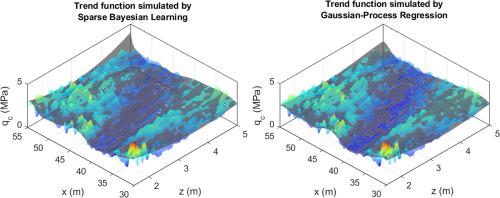Gondwana Research ( IF 7.2 ) Pub Date : 2022-08-02 , DOI: 10.1016/j.gr.2022.07.011 Jianye Ching , Ikumasa Yoshida , Kok-Kwang Phoon

|
This paper compares two probabilistic models for the trend function of geotechnical spatial variability: sparse Bayesian learning (SBL) vs. Gaussian process regression (GPR). For the SBL model (MSBL), the spatial trend is represented as the weighted sum of a sparse set of basis functions (BFs). For the GPR model (MGPR), the spatial trend is represented as a stationary normal random field. The comparison between these two models is based on their Bayesian evidences. The comparison results show that MSBL usually outperforms MGPR with a larger Bayesian evidence when the underlying trend function can be represented by sparse BFs. This usually happens for one-dimensional (1D) simulated examples and 1D real cone penetration test (CPT) examples. However, MGPR usually outperforms MSBL when the spatial trend can not be well represented by sparse BFs. This usually happens for 2D and 3D real CPT examples. Another important contribution of the current paper is the derivations of Kronecker-product formulae for the GPR method. These formulae resolve the issue of the high computational cost for 3D GPR analyses.
中文翻译:

岩土空间变异趋势模型的比较:稀疏贝叶斯学习与高斯过程回归
本文比较了岩土空间变异趋势函数的两种概率模型:稀疏贝叶斯学习 (SBL) 与高斯过程回归 (GPR)。对于 SBL 模型 (M SBL ),空间趋势表示为一组稀疏基函数 (BF) 的加权和。对于 GPR 模型 (M GPR ),空间趋势表示为平稳的正态随机场。这两个模型之间的比较是基于它们的贝叶斯证据。比较结果表明,M SBL通常优于 M GPR当潜在趋势函数可以由稀疏 BF 表示时,具有更大的贝叶斯证据。这通常发生在一维 (1D) 模拟示例和一维实锥穿透测试 (CPT) 示例中。然而,当空间趋势不能用稀疏的 BF 很好地表示时,M GPR通常优于 M SBL 。这通常发生在 2D 和 3D 真实 CPT 示例中。本论文的另一个重要贡献是 GPR 方法的克罗内克积公式的推导。这些公式解决了 3D GPR 分析的高计算成本问题。









































 京公网安备 11010802027423号
京公网安备 11010802027423号